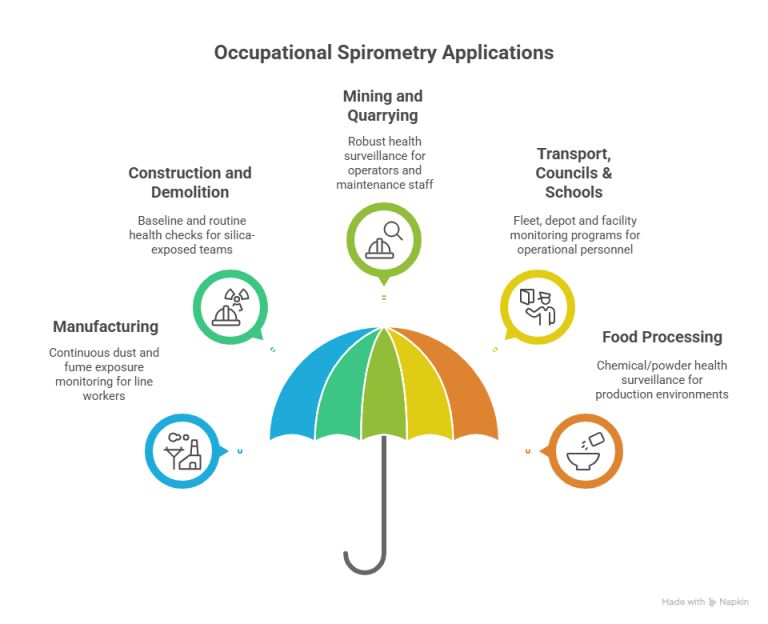In Australian industries, employees are at risk of lung disease when exposed to hazardous airborne substances such as crystalline silica, dust, fumes or gases. National and state legislation makes it mandatory for employers to provide lung function (spirometry) testing for these workers—within three months of their start date and at regular intervals thereafter (SafeWork Australia – Health Monitoring). Adopting this proactive health surveillance not only shields your workforce but ensures legal compliance and reputation is maintained.

Spirometry is safe. Spirometry or Lung Function Test, as its commonly known, is the clinical cornerstone for the screening of workers at risk of occupational lung disease. Spirometry determines whether lungs are functioning at their expected levels. It also helps to diagnose lung and airway diseases, including: Spirometry is the gold standard lung function assessment, widely used in occupational health to:
Measure total air volume inhaled and exhaled, and the speed of airflow
Screen for conditions such as asthma, COPD, pulmonary fibrosis and other chronic respiratory diseases
Benchmark respiratory health against predicted reference values to catch early deviation from ‘normal’
Audiometrics and Medical Personnel is a national company that undertakes pulmonary function test of employees at your site in Victoria, Queensland, New South Wales, South Australia & Western Australia.
Because of its precision and safety, spirometry is recommended for ongoing surveillance in all high-risk workplaces (Wikipedia – Spirometry).
We specialise in national, onsite testing designed for industry schedules and full compliance:
All tests are delivered using advanced diagnostic spirometers with antiviral and antibacterial filters, supporting infection control
Each employee completes three guided breathing trials, with best results used for analysis
Screenings are delivered efficiently at your facility, minimising operational downtimes
Where abnormal results are found, a confidential medical referral pathway is defined as per regulations
Every assessment by our team meets or exceeds:
WorkSafe Victoria Silica Health Monitoring Guide
All reporting supports WorkCover and audit preparation.
Onsite deployment with minimal disruption to your business workflows
Screening and education for all at-risk staff as defined by current WHS law
Detailed, confidential individual and aggregated group reports
Tracking of re-testing cycles and automatic notification for compliance continuity
Follow-up support on recommended medical referrals or further testing as required by law

Every client receives:
Baseline and periodic test values, benchmarked to Australian recommended health ranges
Individual summary and group analytics for site-level health risk management
Flagging of results outside reference range, initiating proactive medical pathways
Documentation formatted for use with WorkCover, regulators, and internal audits
A premium spirometry service incorporating the latest updates and advanced features:
Who must undergo spirometry under WHS laws?
All workers exposed to prescribed hazardous substances at measurable risk, such as crystalline silica or certain welding fumes, must be tested. For example, a new demolition employee is required to complete a baseline assessment (WorkSafe Victoria).
How often do we need to repeat spirometry for high-risk employees?
For most regulated hazards, including crystalline silica, frequency is every two years, but certain roles or findings may require more frequent testing, in line with government advice (SafeWork NSW).
Is the test comfortable? Will my team need to visit a clinic?
Tests are non-invasive, quick, and delivered at your site, managed by experienced clinicians who ensure each worker is comfortable and supported throughout.
What happens if an abnormal result is detected?
Any result outside normal reference ranges is managed confidentially, with immediate referral advice and strict privacy for the worker. Employers receive summary outcome reporting for compliance, not private medical information.
Does your process and reporting meet regulatory audit standards?
Yes. Reports are formatted to support regulatory, WorkCover, and internal requirements, meeting all government-mandated documentation and privacy rules (SafeWork Australia).
For expert service, full confidentiality, and complete workplace compliance, contact Audiometrics & Medical Personnel at 03 9819 4355 or [email protected] Our focus is your workforce health and operational assurance from start to finish.
Lorem ipsum dolor sit amet, consectetur adipiscing elit. Ut elit tellus, luctus nec ullamcorper mattis, pulvinar dapibus leo.

Audiometrics and Medical Personnel ATF The Trustee for KM Future Trust
03 9819 4355
Business Centre Entrance, C4, Level 1/2 Main St, Point Cook VIC 3030, Australia
30 A Verri Street, Griffith, NSW 2680